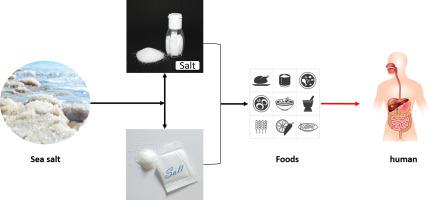Marine Pollution Bulletin ( IF 5.8 ) Pub Date : 2021-01-20 , DOI: 10.1016/j.marpolbul.2021.112006 Oluniyi O. Fadare , Elvis D. Okoffo , Emmanuel F. Olasehinde

|
The presence of micro/plastic particles has been reported in various seafood products. However, information on microplastics contamination in salts from African continent is very limited. This study analysed 23 brands of table salts from 8 African countries for microplastics using microscopic/spectroscopic techniques. South Africa showed the highest microplastics concentration (0–1.33 ± 0.32 particles/kg), Nigeria, Cameroun, and Ghana (0–0.33 ± 0.38 particles/kg each); characterized as polyvinyl acetate, polypropylene, and polyethylene. Other countries have no detectable microplastics at 0.3 μm filter pore size. To our best knowledge, this is the first study to characterize micro-fibres/plastics in table salts across African countries, confirming that it is an emission source of micro-fibres/plastics into the human food chain, highlighting the overarching need to understand their effects on human health.
中文翻译:

非洲食用盐中的微粒和微塑料污染
已经报道了各种海鲜产品中存在微/塑料颗粒。但是,有关非洲大陆盐类中的微塑料污染的信息非常有限。这项研究使用显微镜/光谱技术对来自8个非洲国家的23种食盐品牌进行了微塑料分析。南非的微塑料浓度最高(0-1.33±0.32颗粒/ kg),尼日利亚,喀麦隆和加纳(0-0.33±0.38颗粒/ kg);表征为聚乙酸乙烯酯,聚丙烯和聚乙烯。其他国家/地区的过滤器孔径为0.3μm,没有可检测到的微塑料。据我们所知,这是第一个研究非洲国家食盐中微纤维/塑料特征的研究,证实了它是人类食物链中微纤维/塑料的排放源,



























 京公网安备 11010802027423号
京公网安备 11010802027423号